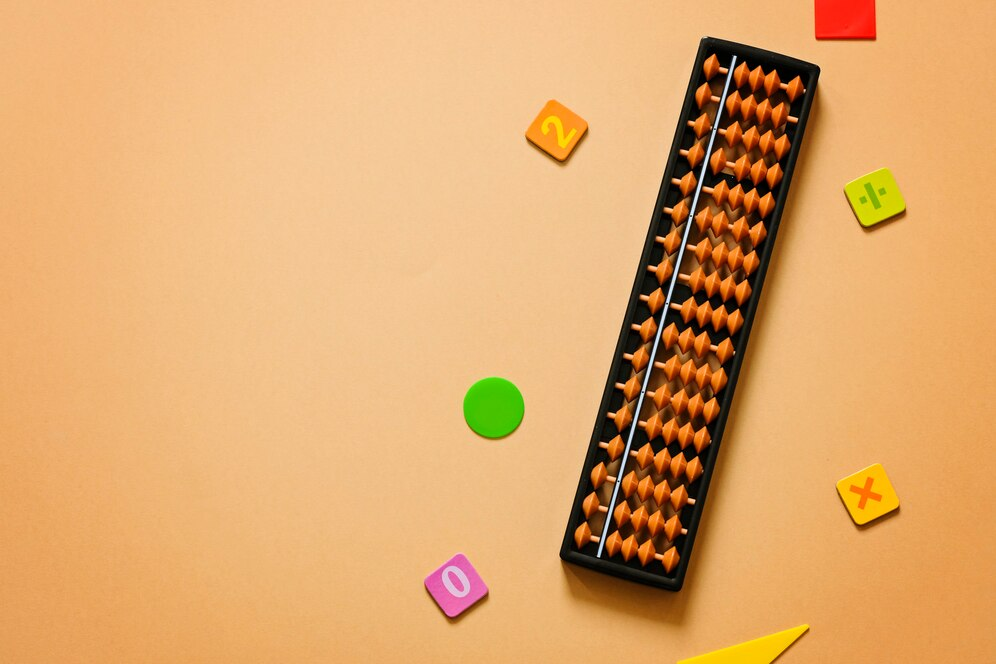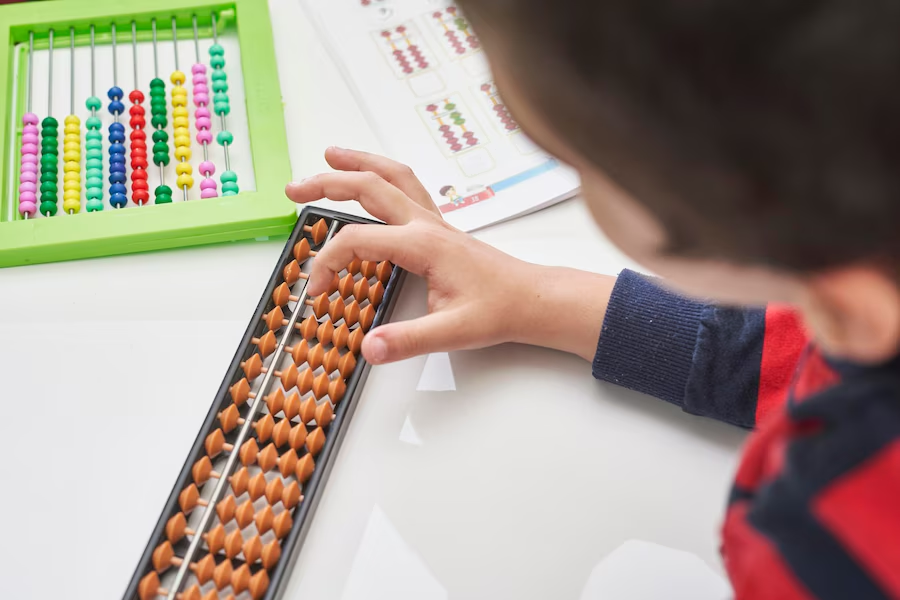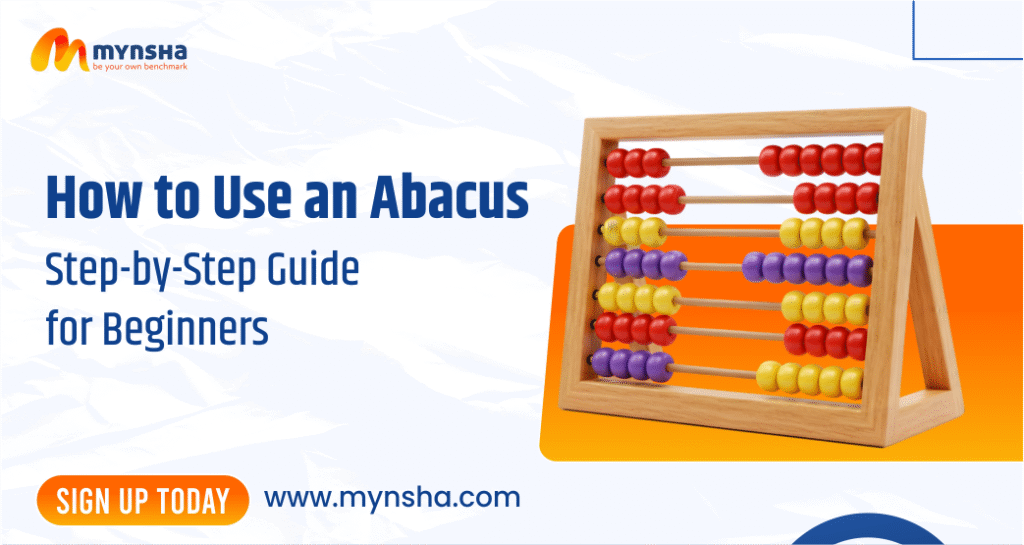In this step-by-step guide, we’ll demonstrate to you exactly how to use an abacus. From learning to count in simple ways to easily adding and subtracting, you’ll discover how this humble yet effective tool can enhance your math skills in no time. Are you ready to discover the magic of the abacus? Let’s begin!
What is an Abacus?
 Abacus is one of the oldest devices to carry out arithmetic, and its simplicity lies in its effectiveness. The most common form of an abacus involves rods with movable beads that are shifted back and forth. Every rod illustrates a unique place value—ones, tens, hundreds, and so on. By shifting the beads toward the center divider, the users are able to express numbers and carry out arithmetic computations. Although there are a number of different abacuses, including Chinese and Russian ones, the Soroban (Japanese abacus) is one of the most used for beginners. It has one bead on the top of each rod (indicating five units) and four beads on the bottom (one unit each). Its simplicity makes it easy to learn how to use abacus every learning effectively.
Abacus is one of the oldest devices to carry out arithmetic, and its simplicity lies in its effectiveness. The most common form of an abacus involves rods with movable beads that are shifted back and forth. Every rod illustrates a unique place value—ones, tens, hundreds, and so on. By shifting the beads toward the center divider, the users are able to express numbers and carry out arithmetic computations. Although there are a number of different abacuses, including Chinese and Russian ones, the Soroban (Japanese abacus) is one of the most used for beginners. It has one bead on the top of each rod (indicating five units) and four beads on the bottom (one unit each). Its simplicity makes it easy to learn how to use abacus every learning effectively.
How Does an Abacus Work?
You probably ask yourself, “How does an abacus work?” The abacus functions based on simple use of the place-value system. Different rods on the abacus are meant to represent a different place value. For instance, the first rod represents the ones place, the second tens place, the third hundreds place, and so on. To write numbers, you shift the beads on the rods. Shifting one bead to the center of the ones rod would write out the number 1, and shifting a bead to the center of the tens rod would write out the number 10. Shifting the beads, you can add, subtract, and even multiply or divide. Using an abacus offers an excellent way to visualize numbers, improving both mental math and problem-solving skills.
Setting Up Your Abacus for Beginners
Before you can start exploring the magic of the abacus, it’s important to set it up correctly:
- Position the abacus: Place the abacus on a flat surface, ensuring that it’s easy to access and handle.
- Set up the beads: For many abacuses, begin by having all of the beads pushed away from the middle divider (to the top and bottom of the rods). This blank slate will assist you in beginning your counting adventure.
Your abacus is now ready to be used. You’re ready to explore the wonderful realm of mathematics!
How to Count on an Abacus
 Counting forms the basis of learning to work with an abacus, and once you know how, you’ll appreciate how much simpler other mathematical concepts become. This is how you can count on an abacus:
Counting forms the basis of learning to work with an abacus, and once you know how, you’ll appreciate how much simpler other mathematical concepts become. This is how you can count on an abacus:
- One’s Place (far right rod): The single most important point is to transport one bead at a time from the ends inwards towards the center of the ones rod to convey numbers from 1 to 9. Illustrating, having one bead moves means 1, having two beads moves indicates 2, and so on.
- Tens Place (second rod): After you’ve learned to count up to 9, you can proceed to the second rod. There are 10 beads in this row. To illustrate, moving one bead on the second rod denotes the number 10, two beads mean 20, and so on.
The hands-on experience will help you better understand place value and make counting more natural.
How to Use an Abacus for Addition
Addition is perhaps the simplest thing to do on the abacus. Here’s how to add two numbers together with this amazing tool, Let’s add 5+1: Start again: Push all the beads from the center beam (this is your “zero” position”). Add the first digit (3): On the ones rod (the far-right rod), place 3 lower beads on the center beam. You’ve just entered the digit 3. Add the second digit (3): You need to add 3 more beads. But you only have 1 lower bead to spare (since only 4 exist). So, do this: Move the 3 bottom beads down (remove them). Move up 1 top bead (5). Then move up 1 bottom bead. That is 5 + 1 = 6 End result: You have 1 top bead (5) and 1 bottom bead (1) near the beam. So the answer is 6. For bigger sums, such as 17 + 28, you will have to move beads on both the tens and ones rods. That is where the abacus is effective; it makes you see the value of carrying over values, just as you would do on paper.
How to Use an Abacus for Subtract
Subtraction is not any harder on the abacus. Let’s go through an example of 6 – 2.
- Begin with the first number: Take 6 beads towards the center of the ones rod.
- Subtract the second number: Subtract by moving 2 beads back away from the center of the rod.
- The result: After adjusting the beads, you’ll be left with 4 beads in the ones place, representing the result of 6 – 2 = 4.
This process is quick and helps reinforce your understanding of numbers and subtraction.
Tips for Improving Your Speed and Accuracy
Once you’ve mastered the basics of using an abacus, it’s time to improve your speed and accuracy. Here are some helpful tips to practice:
- Prioritize accuracy initially: It’s better to get the right amount of beads first before trying to work faster. Accuracy will eventually result in faster calculations.
- Regular practice: The more you practice, the faster and more confident you’ll get.
Conclusion
Now that you have learned “how do you use an abacus”, practice is the key to experiencing the benefits for yourself. Whether you want to enhance your mathematics skills or need a great tool to teach others, the abacus is priceless. Through the practice of counting, addition, and subtraction, you will enhance your math skills as well as your problem-solving skills. Pick up your abacus, practice, and harness the power of numbers! Mastering Mental Math. Mastering Abacus.
FOLLOW US ON FACEBOOK, INSTAGRAM & LINKEDIN for regular updates.
BOOK OUR ABACUS COURSE FREE DEMO NOW
#Abacus #AbacusClasses #LearningAbacus #AbacusTool #CalculatingOnAbacus #HistoryOfAbacus #HowToUseAbacus #UnderstandingAbacusTool #UsingAbacus #MynshaLearning



